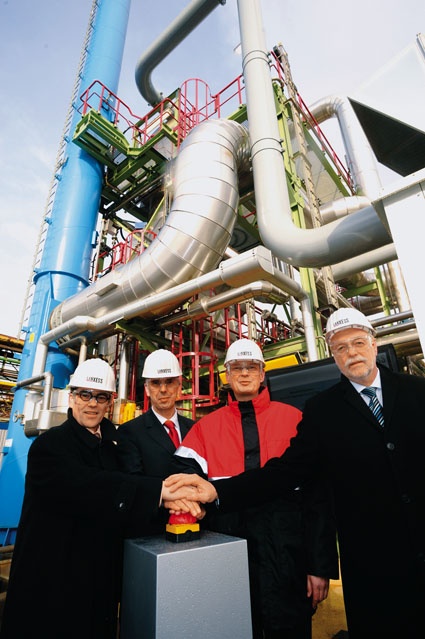

By putting a second nitrous oxide reduction plant (LARA) into operation at the Chempark Krefeld-Uerdingen site in Germany, specialty chemicals group Lanxess has moved a big step closer to its climate protection target, namely reducing annual emissions of carbon dioxide equivalents (CO2(e)) by around 1.5 million metric tons. By 2012, the Leverkusen-based company is aiming to cut direct emissions of harmful gases in Germany by 80 % compared to 2007 levels. The LARA project also demonstrates that climate protection can result in both environmental and economic benefits.
"We must not use the economic crisis as an excuse to back-pedal and cut back on environmental protection measures," insisted Dr. Axel C. Heitmann, Chairman of the Board of Management of Lanxess, at the inauguration of the new plant in Krefeld, which has required an investment of around €10 million. He stressed that this was a "lighthouse project" that highlighted the way to go in both environmental and economic terms. Depending on the capacity utilization of the adipic acid production facility which generates nitrous oxide, an additional 5,000 metric tons of the gas can now be destroyed and disposed of in an environmentally friendly way each year. The new plant was built and approved in a record time of just 10 months. Heitmann praised the excellent cooperation with the responsible authorities.
Emissions Allowances Create an Investment Incentive
The investment costs are being refinanced under a joint implementation project. This is the first such industrial undertaking to be approved by the German authorities and already be completed. It makes use of the emissions trading allowances that are provided for in the Kyoto Protocol and have been traded on European markets since 2005.
Under this program, an emitter of greenhouse gases such as an industrial company or power plant operator is allocated a number of emissions allowances. If not all are used, the surplus "pollution rights" can be sold on the free market. Although the prices for these allowances have fallen sharply over the past year - from over €20 per metric ton of CO2 emitted to less than €10 just recently - selling allowances under the joint implementation project, which runs to 2012, not only enables refinancing, but can also make climate protection a profitable investment. What's more, the plant is designed to operate long after 2012 and will thus continue to make a contribution to climate protection in subsequent years.
Even through the primary objective of emissions trading is not to lower overall emissions, it does create incentives for more climate-friendly energy and industrial production - as this example shows. It also helps cut specific emissions per product or product unit.
Thermal Nitrous Oxide Reduction
Nitrous oxide (also sometimes known as laughing gas) is a non-flammable, non-toxic narcotic gas that is used today as a blowing agent for products such as aerosol whipped cream. It is one of the most harmful gases for our climate - around 310 times more harmful than carbon dioxide according to experts.
Nitrous oxide is generated as a by-product during the industrial production of nitric acid and the oxidative ring cleavage of KA oil to produce adipic acid. KA oil - a combination of cyclohexanol and cyclohexanone - is produced from cyclohexane in an upstream reaction. The production of adipic acid is a key step in the manufacture of polyamide 66 plastics. This class of plastics includes numerous high-quality engineering thermoplastics produced by Lanxess's Semicrystalline Products business unit under the name Durethan. Areas of application include the automotive, electrical and electronics industries.
For every metric ton of adipic acid produced, around 300 kg of nitrous oxide is generated. Given Lanxess's annual production capacity of approximately 88,000 metric tons of adipic acid, this means that huge amounts of nitrous oxide are generated. Since the early 1990s, 85 - 90 % has been destroyed in a reduction plant in Krefeld. The plant makes use of the fact that nitrous oxide is metastable, i.e. it breaks down into nitrogen and oxygen and gives off heat in the process. A substantial amount of energy is released and can be put to good use.
Nitrous Oxide Reduction
To make the speed at which nitrous oxide breaks down more technically exploitable, high temperatures in excess of 1,000 °C are required. This is achieved in the Krefeld plants by means of natural gas firing. The hot reaction gas is first routed to a second combustion chamber and then to a steam generator. The steam fed into the site grid ensures a very favorable overall energy balance. According to Dr. Peter Persigehl, head of the Adipic Acid business line at Lanxess in Krefeld-Uerdingen, "the energy content of the steam generated is equivalent to around 60 - 70 % of the energy content of the natural gas and electricity required for the process."
The main objective of the second plant, which has just begun operation, is to ensure that no nitrous oxide is ever released into the atmosphere. "The two plants give us sufficient redundant nitrous oxide reduction capacity. During maintenance periods or if there is a malfunction in one plant, the other plant steps in," explains Persigehl. He expects the combined availability of the two plants to be close to 100 %.
Although a number of different processes exist and are also used for nitrous oxide separation, the purely thermal process developed by Lanxess stands out in a number of respects. The company boasts nearly 20 years of practical experience that has resulted in numerous improvements being made to the process. This experience was drawn on when planning the new plant. Technically speaking, the process is relatively simple, which makes it particularly robust. "The main benefit of our know-how is the ability it gives us to optimize the process to ensure that the nitrous oxide is separated completely without producing nitrogen oxides (NOx). We utilize state-of-the-art online sensor technology and a complex control concept," states Persigehl.
Climate Protection
Given that nitrous oxide is extremely harmful to the climate, reducing emission levels for this gas represents a very effective means of lowering overall emissions. This makes the use of emissions trading particularly attractive for financing such measures.
Lanxess's overall objective is to reduce greenhouse gas emissions in Germany by 80 % between 2007, when emissions totaled approximately 1.9 million metric tons of CO2(e), and 2012. This target is essentially met given that the new nitrous oxide reduction plant has the potential to cut annual emissions by around 1.5 million metric tons of CO2(e). Other measures are also helping to cut greenhouse gas emissions at Lanxess. The company's rubber production facility at Port Jérôme in France is benefiting from the recent addition of a highly efficient waste air after burning plant that hardly uses any fossil fuels and is capable of halving CO2 emissions compared with conventional processes.
Another very efficient strategy for cutting emissions is CO2-neutral energy generation from renewable raw materials. Lanxess has adopted this strategy, for example, at its Brazilian site in Porto Feliz where a power plant based on the combined heat and power generation concept with an output of 4.5 MW is currently under construction. The plant is scheduled to be taken into operation in 2010 and will ensure the long-term supply of energy at the site. Bagasse - plant fibers that are a by-product of sugar cane processing - is used as a fuel. Last but not least, biomass from agricultural waste is used for energy generation at the Thane site in India. There are many routes to climate-friendly production.






